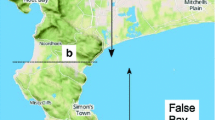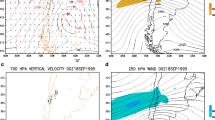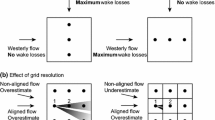Summary
The wind regime of the Canterbury region, New Zealand, is composed of several interacting multi-scale wind systems all of which show strong diurnal periodicity. The dynamic orographic effect of the Southern Alps on the prevailing westerly flow results in perturbations to the pressure field and localized antitriptic airflow. Superimposed on this larger scale process are thermotopographic effects resulting from both regional and local land-sea thermal contrasts and slope heating. These processes act within an hierarchy of scales to produce a complex wind regime characterized by marked temporal variability, a layered vertical structure and the frequent occurrence of convergence lines and shear zones. The synergistic nature of the forcing mechanisms and the tendency for nocturnal decoupling of the boundary layer due to stability variations makes it difficult to differentiate and label discrete wind components.
Attempts to simulate this regime using the Colorado State University mesoscale model showed that the model was unable to adequately resolve both the dynamic orographic effect and the local thermotopographic effect because of their differing scales of influence. These results suggest that a more holistic approach to both empirical and theoretical studies in such environments is required if more accurate wind field forecasting is to be achieved.
Zusammenfassung
Das Windregime des Gebiets von Canterbury, Neuseeland, setzt sich aus verschiedenen zusammenwirkenden Windsystemen verschiedener Größenordnungen zusammen, die alle einen starken Tagesgang aufweisen. Der dynamisch-orographische Effekt der neuseeländischen Alpen auf die vorherrschende Westströmung führt zu Störungen im Druckfeld und lokalen Luftbewegungen im Lee. Diesem großräumigen Prozeß sind thermisch-topographische Effekte überlagert, die sowohl durch regionale als auch lokale thermische Unterschiede zwischen Land und Meer und die Erwärmung der Hangregion hervorgerufen werden. Die Vorgänge spielen sich in einer Hierarchie von Größenordnungen ab. Sie erzeugen ein kompliziertes Windsystem, das durch hohe zeitliche Variabilität, eine schichtweise thermische Struktur und häufige Konvergenz- und Scherungszonen gekennzeichnet ist. Die synergetische Natur der Antriebe und die Tendenz zum nächtlichen Entkoppeln der planetaren Grenzschicht aufgrund von Stabilitätsschwankungen macht es schwer, die einzelnen Windkomponenten zu trennen und zuzuordnen.
Die Versuche, dieses Regime mit Hilfe des Mesoscale-Modells der Colorado State University zu simulieren, zeigten, daß es aufgrund der verschiedenen Größenordnungen des Einflusses nicht geeignet war, gleichzeitig den dynamisch-orographischen und den thermo-topographischen Effekt zu reproduzieren. Diese Ergebnisse legen sowohl für empirische wie für theoretische Untersuchungen einen holistischeren Ansatz nahe, um eine genauere Prognose des Windfeldes zu ermöglichen.
Similar content being viewed by others
References
Atkinson BW (1981) Mesoscale atmospheric circulations. Academic Press, London
Barry RG, Perry AH (1973) Synoptic climatology: methods and applications. Methuen, London
Clements WE, Nappo CJ (1983) Observation of a drainage flow event on a high-altitude simple slope. J. of Clim Appl Met 22:331–335
de Lisle JF (1969) The climate and weather. In: Knox GA (ed) The natural history of Canterbury. Reed, Wellington, pp 68–76
Fosberg MA, Marlatt WE, Krupnak L (1976) Estimating airflow patterns over complex terrain. USDA Forest Service, Rocky Mountain Forest and Range Experimental Station, Res Paper RM-162, p 16
Gutman LN (1983) On the theory of the katabatic slope wind. Tellus A35:213–218
Hill HW (1979) Severe damage to forests in Canterbury, New Zealand, resulting from orographically reinforced winds. New Zealand Meteorological Service, Tech Informat Circ No 169
Huss A, Feliks Y (1981) A mesometeorological numerical model of the sea and land breezes involving seaatmospheric interactions. Contr Atm Phys 54: 238–257
Keen CS, Lyons WA (1978) Lake/land breeze circulations on the western shore of Lake Michigan. J Appl Met 17:1843–1855
McKendry IG (1983) Spatial and temporal aspects of the surface wind regime on the Canterbury Plains, New Zealand. J Clim 3:155–166
McKendry IG (1985) An empirical and numerical modelling analysis of a complex mesoscale wind field, Canterbury Plains, New Zealand. Ph D thesis, University of Canterbury, Geography Department, Christchurch, New Zealand, p. 388
McRae GR, Shair FH, Seinfeld JH (1981) Convective downmixing of plumes in a coastal environment. J Appl Met 20:113–1324
Mahrer A, Pielke RA (1977) The effects of topography on the sea and land breezes in a two-dimensional numerical model. Mon Wea Rev 105:1152–1162
Mahrer A, Pielke RA (1978) A test of an upstream spline interpolation technique for the advective terms in a numerical mesoscale model. Mon Wea Rev 106:818–830
Manins PC, Sawford BL (1979) Katabatic winds: a field case study. Quart J R Met Soc 105:1011–1025
Maunder WJ (1971) The climate of New Zealand —physical and dynamic features. In: Gentilli J (ed) Climates of Autralia and New Zealand. World Survey of Climatology 13: 213–227, Elsevier, Amsterdam
Misra PK, McMillan AC (1980) On the dispersion parameters of plumes from tall stacks in a shoreline environment. Bound Layer Met 19:175–185
Neale AA, Thompson GH (1978) Surface winds in coastal waters off Westland. New Zealand Meteorological Service, Tech Note No 234
Physik WL (1976) A numerical model of the sea-breeze phenomenon over a lake of gulf. J Atm Sci 33: 2107–2135
Physik WL (1980) Numerical experiments on the inland penetration of the sea breeze. Quart J R Met Soc 106:735–746
Pielke RA (1974) A three-dimensional numerical model of the sea breezes over south Florida. Mon Wea Rev 102:115–139
Pielke RA (1984) Mesoscale meteorological modelling: an introductory survey. Academic Press, New York
Pielke RA, Mahrer Y (1978) Verification analysis of the University of Virginia three-dimensional mesoscale model prediction over south Florida for July 1, 1973. Mon Wea Rev 106:1568–1589
Pierrehumbert RT, Wyman B (1985) Upstream effects of mesoscale mountains. J Atm Sci 42:977–1003
Ryan AP (1980) Northwest drifts and night cooling in w5nter in Christchurch. New Zealand Meteorological Service, Tech Note No 243
Ryan BC (1977) A mathematical model for diagnosis and prediction of surface winds in mountainous terrain. J Appl Met 16:571–584
Schlunzen H, Schatzmann M (1984) Atmosphärische Mesoscale-Modelle — ein Überblick. Hamburger geophysikalische Einzelschriften, Reihe B, Technische Abhandlungen Heft 3
Simpson JE, Mansfield DA, Milford JR (1977) Inland penetration of sea-breeze fronts. Quart J R Met Soc 103:47–76
Smith RB (1982) Synoptic observations and theory of orographically disturbed wind and pressure. J Atm Sci 39:60–70
Sturman AP (1985) An examination of the role of local wind systems in the concentration and dispersion of smoke pollution in Christchurch, New Zealand. New Zealand Geographer, in press
Sturman AP, McKendry IG (1984) Detailed analysis of the structure of local wind systems in Canterbury, New Zealand. In: Proc of Nowcasting-II Symposium, Norrkiping, Sweden, 3–7 Sept. European Space Agency, Special Pub 208:81–85
Sturman AP, Trewinnard AC, Gorman PA (1984) A study of atmospheric circulation over the South Island of New Zealand (1961–1980). Weather and Climate 4:53–62
Sturman AP, Tyson PD (1981) Sea breezes along the Canterbury coast in the vicinity of Christchurch, New Zealand. J Clim 1:203–219
Tomlinson AI (1976) Climate. In: Wards I (ed), New Zealand atlas, Government. Printer, Wellington, pp 82–89
Trenberth KE (1977) Surface atmospheric tides in New Zealand. New Zealand J of Science 20:339–356
Author information
Authors and Affiliations
Additional information
With 11 Figures
Rights and permissions
About this article
Cite this article
McKendry, I.G., Sturman, A.P. & Owens, I.F. A study of interacting multi-scale wind systems, Canterbury plains, New Zealand. Meteorl. Atmos. Phys. 35, 242–252 (1986). https://doi.org/10.1007/BF01041817
Received:
Revised:
Issue Date:
DOI: https://doi.org/10.1007/BF01041817




